FIFA World Cup: Diplomacy, South Africa and Brazil Case Studies
VerifiedAdded on 2022/09/15
|50
|16578
|18
Essay
AI Summary
This dissertation, submitted for the MA in Global Diplomacy at the School of Oriental and African Studies, investigates the multifaceted relationship between the FIFA World Cup and international diplomacy. It examines how mega-sporting events are utilized as diplomatic tools, focusing on the 2010 World Cup in South Africa and the 2014 World Cup in Brazil. The research analyzes the impact of these events on host nations, including infrastructure development, economic implications, and the influence of FIFA. It explores theories of sports diplomacy, cultural diplomacy, and soft power, and how these concepts relate to the FIFA World Cup. The study also assesses the role of the FIFA World Cup in the context of corruption and the broader implications for global politics and diplomacy. The research also looks into the role of South Africa and Brazil in the world stage after hosting the World Cup.
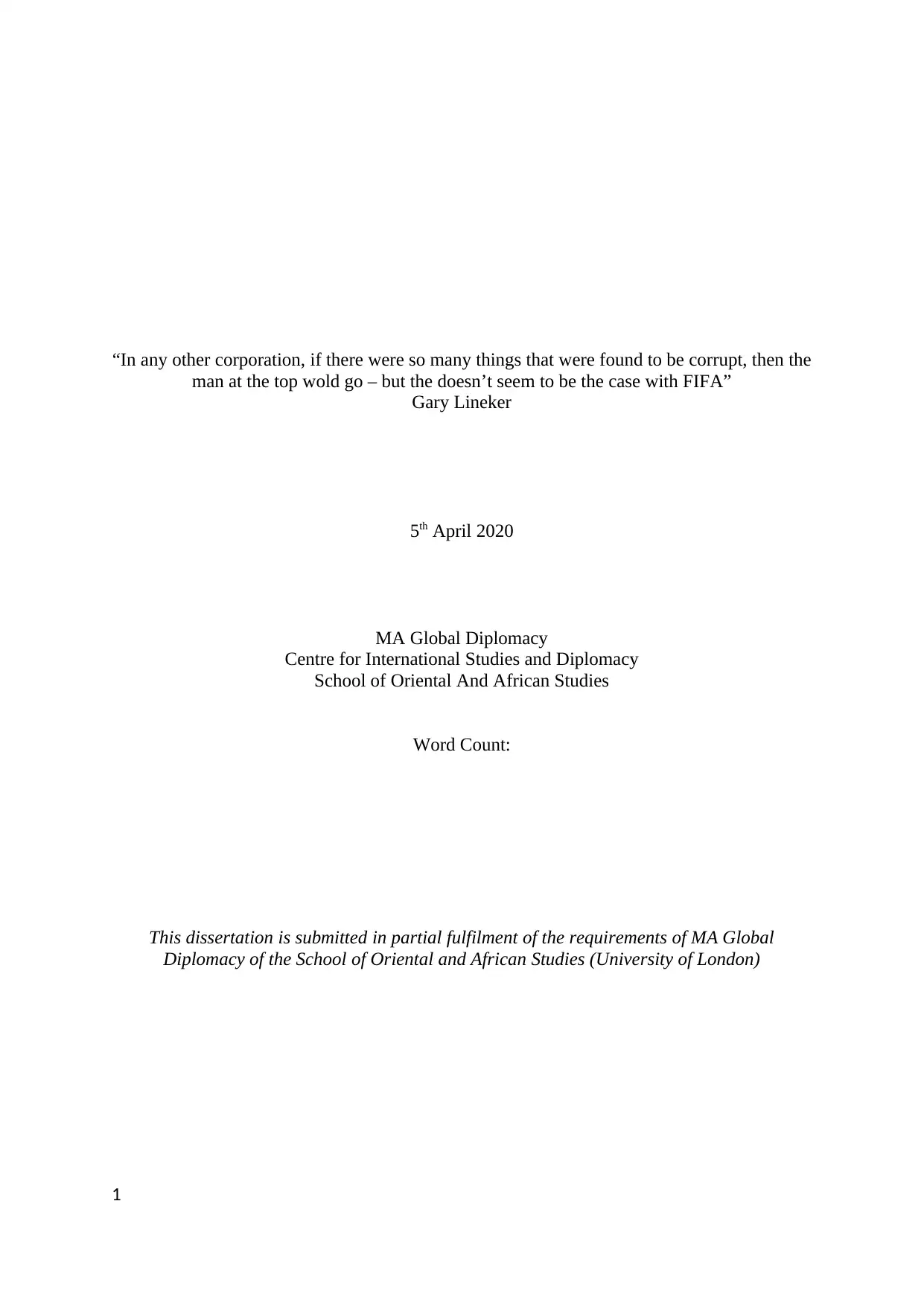
“In any other corporation, if there were so many things that were found to be corrupt, then the
man at the top wold go – but the doesn’t seem to be the case with FIFA”
Gary Lineker
5th April 2020
MA Global Diplomacy
Centre for International Studies and Diplomacy
School of Oriental And African Studies
Word Count:
This dissertation is submitted in partial fulfilment of the requirements of MA Global
Diplomacy of the School of Oriental and African Studies (University of London)
1
man at the top wold go – but the doesn’t seem to be the case with FIFA”
Gary Lineker
5th April 2020
MA Global Diplomacy
Centre for International Studies and Diplomacy
School of Oriental And African Studies
Word Count:
This dissertation is submitted in partial fulfilment of the requirements of MA Global
Diplomacy of the School of Oriental and African Studies (University of London)
1
Paraphrase This Document
Need a fresh take? Get an instant paraphrase of this document with our AI Paraphraser
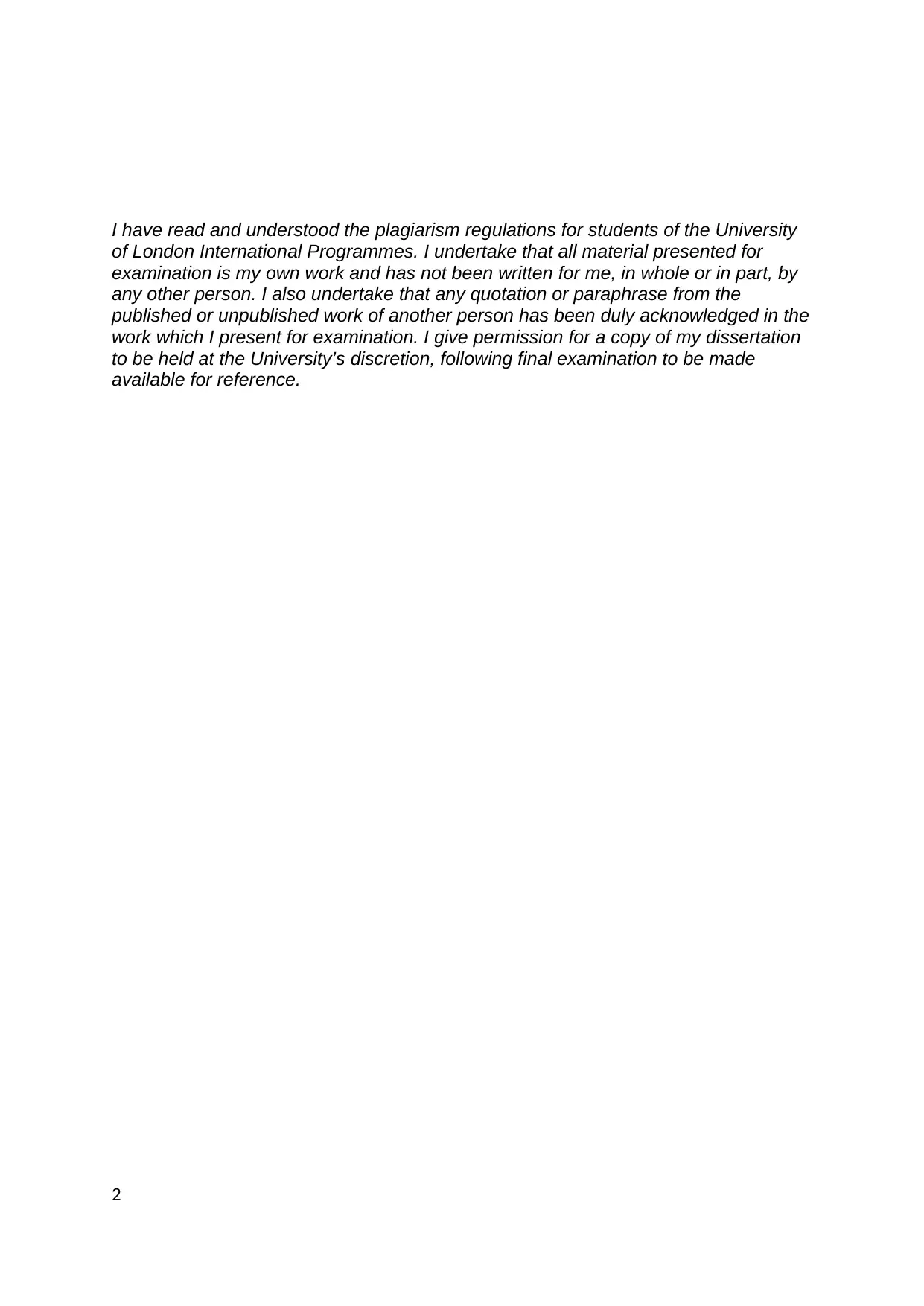
I have read and understood the plagiarism regulations for students of the University
of London International Programmes. I undertake that all material presented for
examination is my own work and has not been written for me, in whole or in part, by
any other person. I also undertake that any quotation or paraphrase from the
published or unpublished work of another person has been duly acknowledged in the
work which I present for examination. I give permission for a copy of my dissertation
to be held at the University’s discretion, following final examination to be made
available for reference.
2
of London International Programmes. I undertake that all material presented for
examination is my own work and has not been written for me, in whole or in part, by
any other person. I also undertake that any quotation or paraphrase from the
published or unpublished work of another person has been duly acknowledged in the
work which I present for examination. I give permission for a copy of my dissertation
to be held at the University’s discretion, following final examination to be made
available for reference.
2
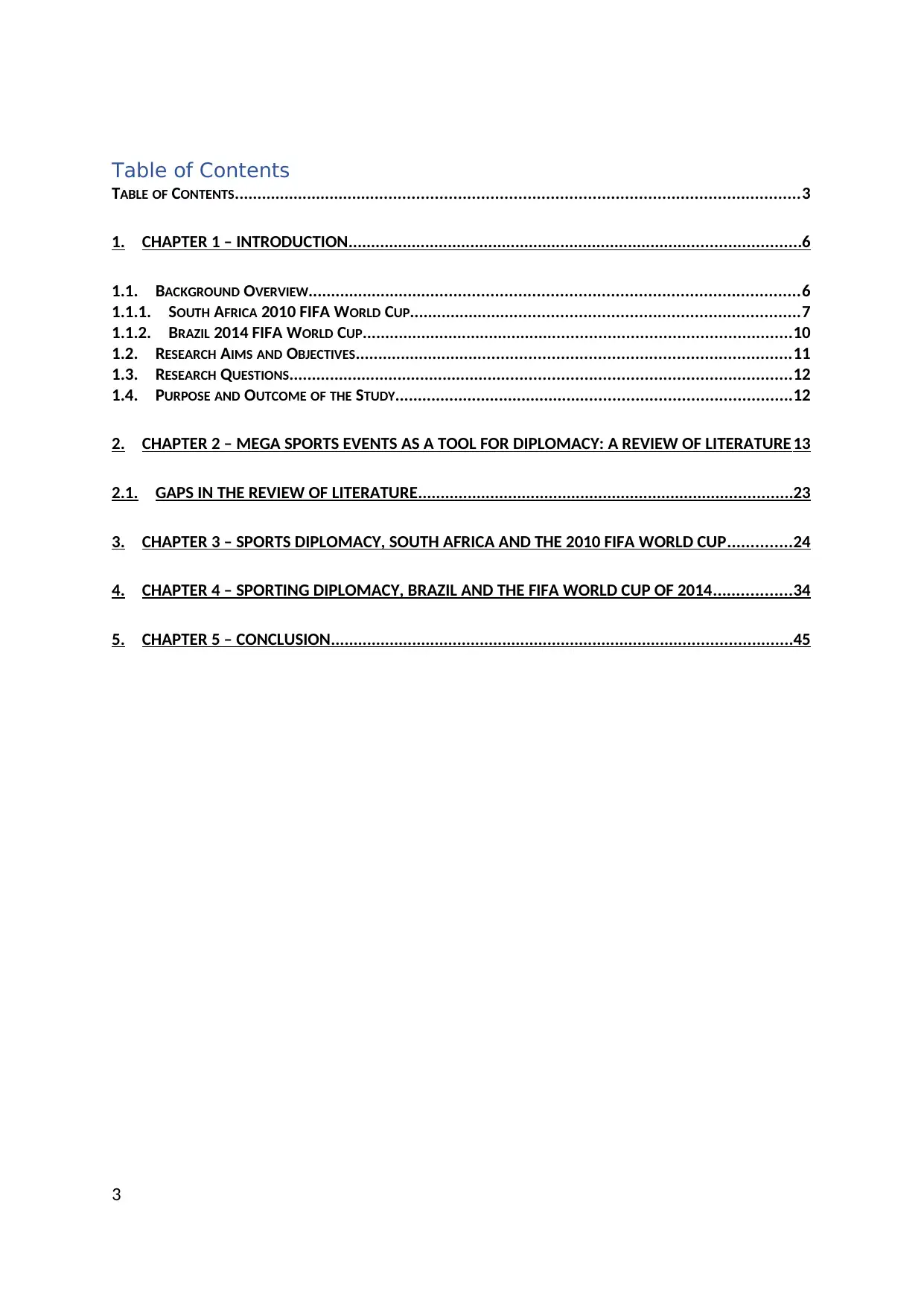
Table of Contents
TABLE OF CONTENTS...........................................................................................................................3
1. CHAPTER 1 – INTRODUCTION....................................................................................................6
1.1. BACKGROUND OVERVIEW...........................................................................................................6
1.1.1. SOUTH AFRICA 2010 FIFA WORLD CUP.....................................................................................7
1.1.2. BRAZIL 2014 FIFA WORLD CUP..............................................................................................10
1.2. RESEARCH AIMS AND OBJECTIVES...............................................................................................11
1.3. RESEARCH QUESTIONS..............................................................................................................12
1.4. PURPOSE AND OUTCOME OF THE STUDY.......................................................................................12
2. CHAPTER 2 – MEGA SPORTS EVENTS AS A TOOL FOR DIPLOMACY: A REVIEW OF LITERATURE 13
2.1. GAPS IN THE REVIEW OF LITERATURE...................................................................................23
3. CHAPTER 3 – SPORTS DIPLOMACY, SOUTH AFRICA AND THE 2010 FIFA WORLD CUP..............24
4. CHAPTER 4 – SPORTING DIPLOMACY, BRAZIL AND THE FIFA WORLD CUP OF 2014.................34
5. CHAPTER 5 – CONCLUSION......................................................................................................45
3
TABLE OF CONTENTS...........................................................................................................................3
1. CHAPTER 1 – INTRODUCTION....................................................................................................6
1.1. BACKGROUND OVERVIEW...........................................................................................................6
1.1.1. SOUTH AFRICA 2010 FIFA WORLD CUP.....................................................................................7
1.1.2. BRAZIL 2014 FIFA WORLD CUP..............................................................................................10
1.2. RESEARCH AIMS AND OBJECTIVES...............................................................................................11
1.3. RESEARCH QUESTIONS..............................................................................................................12
1.4. PURPOSE AND OUTCOME OF THE STUDY.......................................................................................12
2. CHAPTER 2 – MEGA SPORTS EVENTS AS A TOOL FOR DIPLOMACY: A REVIEW OF LITERATURE 13
2.1. GAPS IN THE REVIEW OF LITERATURE...................................................................................23
3. CHAPTER 3 – SPORTS DIPLOMACY, SOUTH AFRICA AND THE 2010 FIFA WORLD CUP..............24
4. CHAPTER 4 – SPORTING DIPLOMACY, BRAZIL AND THE FIFA WORLD CUP OF 2014.................34
5. CHAPTER 5 – CONCLUSION......................................................................................................45
3
⊘ This is a preview!⊘
Do you want full access?
Subscribe today to unlock all pages.

Trusted by 1+ million students worldwide
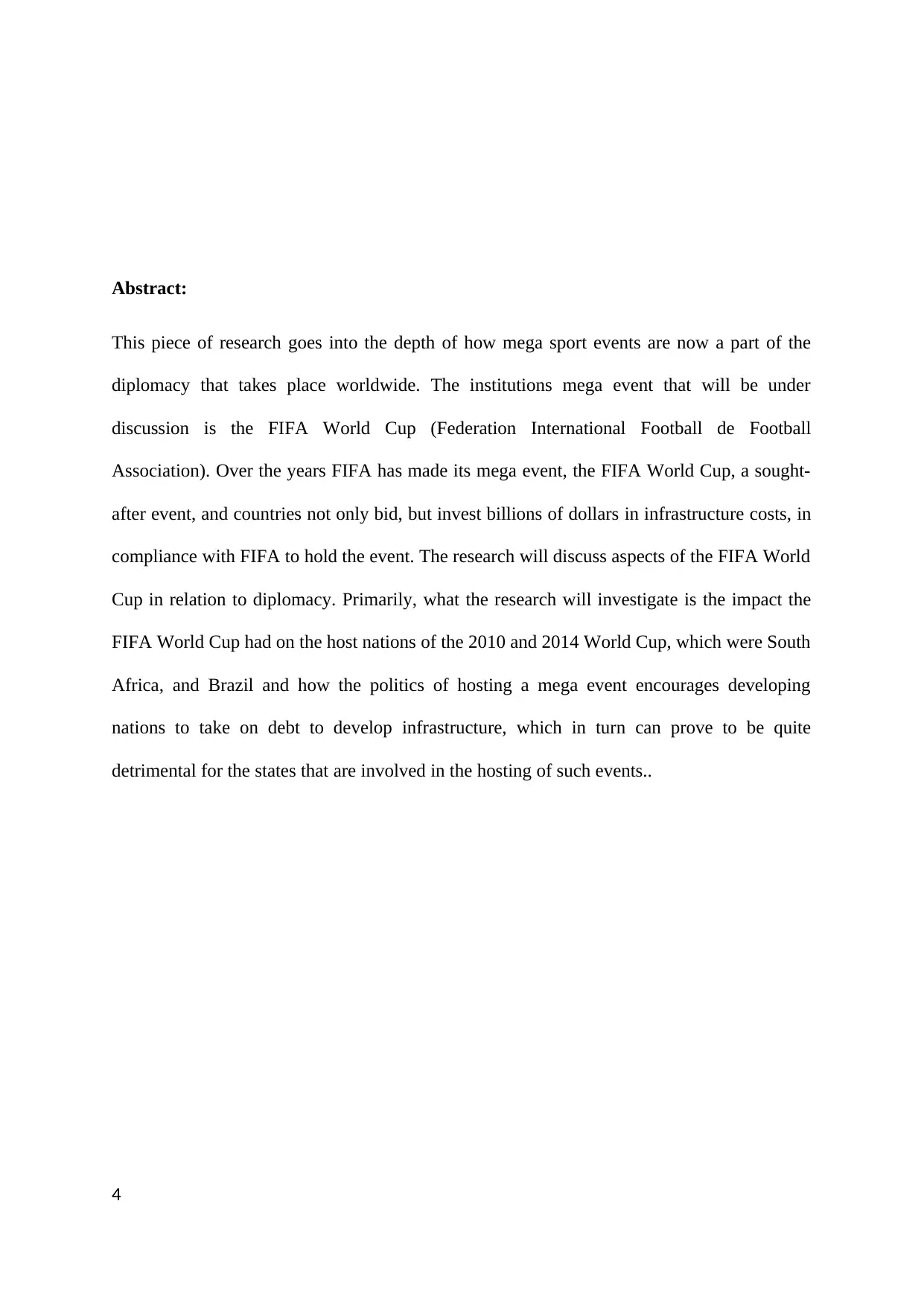
Abstract:
This piece of research goes into the depth of how mega sport events are now a part of the
diplomacy that takes place worldwide. The institutions mega event that will be under
discussion is the FIFA World Cup (Federation International Football de Football
Association). Over the years FIFA has made its mega event, the FIFA World Cup, a sought-
after event, and countries not only bid, but invest billions of dollars in infrastructure costs, in
compliance with FIFA to hold the event. The research will discuss aspects of the FIFA World
Cup in relation to diplomacy. Primarily, what the research will investigate is the impact the
FIFA World Cup had on the host nations of the 2010 and 2014 World Cup, which were South
Africa, and Brazil and how the politics of hosting a mega event encourages developing
nations to take on debt to develop infrastructure, which in turn can prove to be quite
detrimental for the states that are involved in the hosting of such events..
4
This piece of research goes into the depth of how mega sport events are now a part of the
diplomacy that takes place worldwide. The institutions mega event that will be under
discussion is the FIFA World Cup (Federation International Football de Football
Association). Over the years FIFA has made its mega event, the FIFA World Cup, a sought-
after event, and countries not only bid, but invest billions of dollars in infrastructure costs, in
compliance with FIFA to hold the event. The research will discuss aspects of the FIFA World
Cup in relation to diplomacy. Primarily, what the research will investigate is the impact the
FIFA World Cup had on the host nations of the 2010 and 2014 World Cup, which were South
Africa, and Brazil and how the politics of hosting a mega event encourages developing
nations to take on debt to develop infrastructure, which in turn can prove to be quite
detrimental for the states that are involved in the hosting of such events..
4
Paraphrase This Document
Need a fresh take? Get an instant paraphrase of this document with our AI Paraphraser
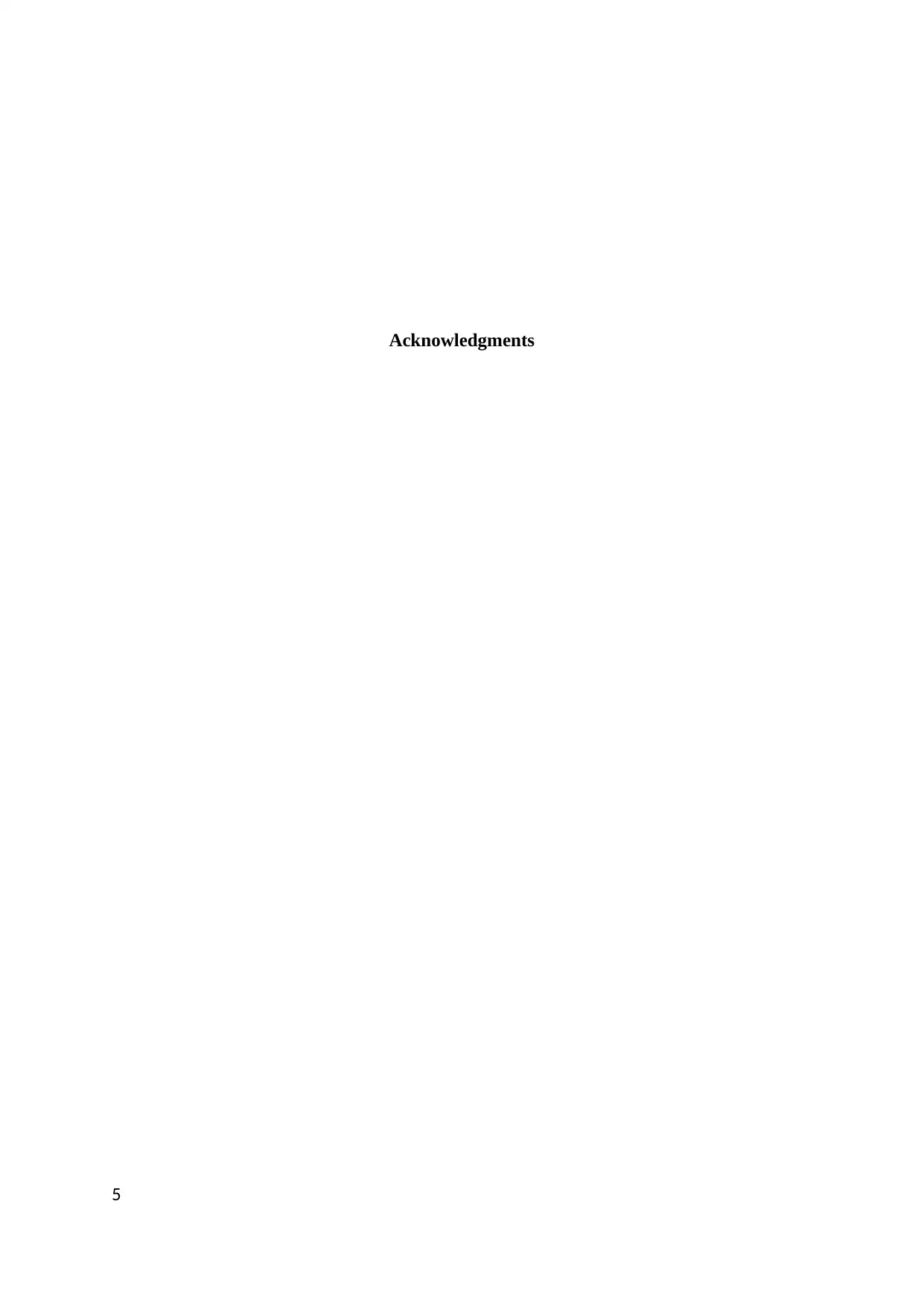
Acknowledgments
5
5
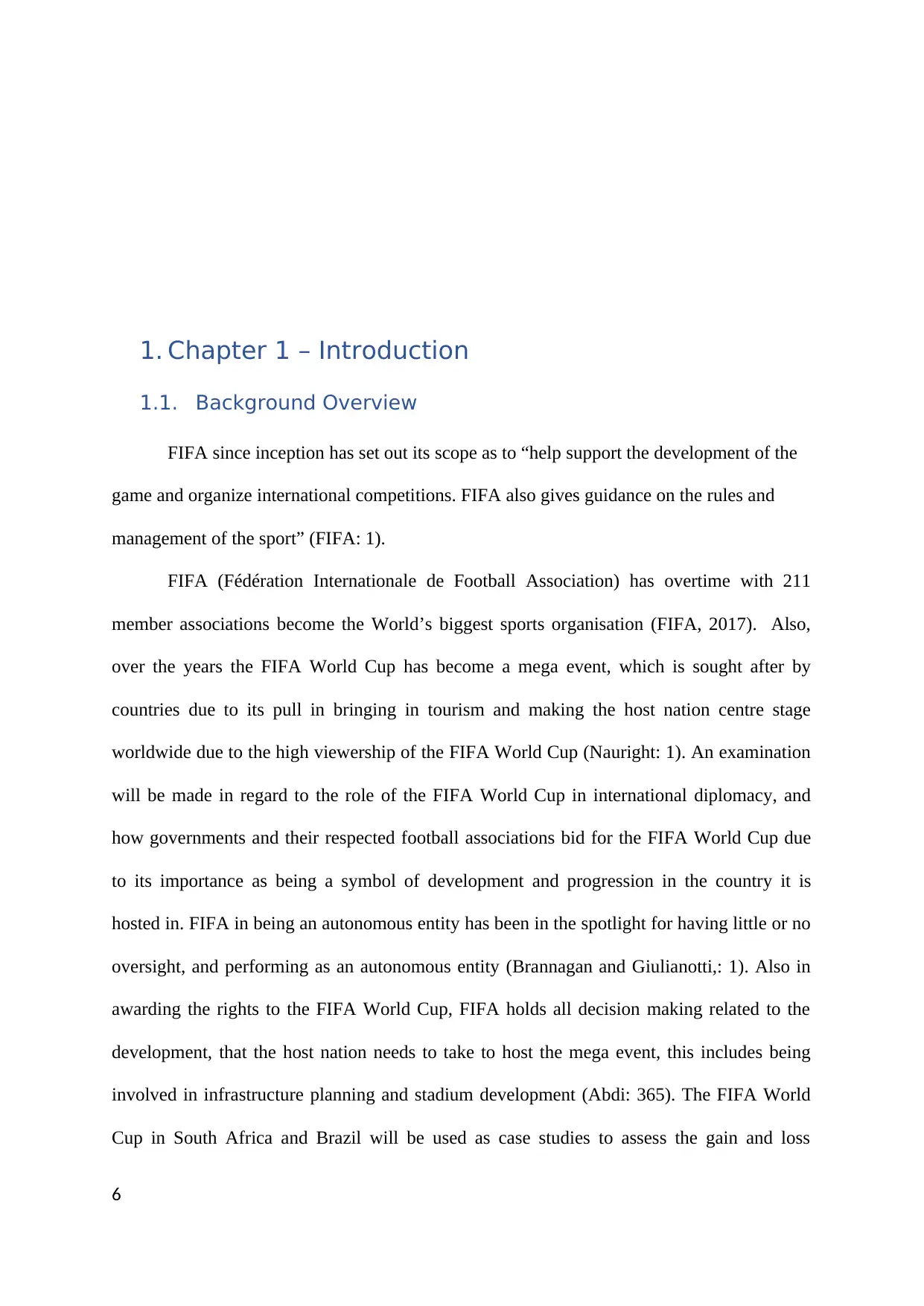
1. Chapter 1 – Introduction
1.1. Background Overview
FIFA since inception has set out its scope as to “help support the development of the
game and organize international competitions. FIFA also gives guidance on the rules and
management of the sport” (FIFA: 1).
FIFA (Fédération Internationale de Football Association) has overtime with 211
member associations become the World’s biggest sports organisation (FIFA, 2017). Also,
over the years the FIFA World Cup has become a mega event, which is sought after by
countries due to its pull in bringing in tourism and making the host nation centre stage
worldwide due to the high viewership of the FIFA World Cup (Nauright: 1). An examination
will be made in regard to the role of the FIFA World Cup in international diplomacy, and
how governments and their respected football associations bid for the FIFA World Cup due
to its importance as being a symbol of development and progression in the country it is
hosted in. FIFA in being an autonomous entity has been in the spotlight for having little or no
oversight, and performing as an autonomous entity (Brannagan and Giulianotti,: 1). Also in
awarding the rights to the FIFA World Cup, FIFA holds all decision making related to the
development, that the host nation needs to take to host the mega event, this includes being
involved in infrastructure planning and stadium development (Abdi: 365). The FIFA World
Cup in South Africa and Brazil will be used as case studies to assess the gain and loss
6
1.1. Background Overview
FIFA since inception has set out its scope as to “help support the development of the
game and organize international competitions. FIFA also gives guidance on the rules and
management of the sport” (FIFA: 1).
FIFA (Fédération Internationale de Football Association) has overtime with 211
member associations become the World’s biggest sports organisation (FIFA, 2017). Also,
over the years the FIFA World Cup has become a mega event, which is sought after by
countries due to its pull in bringing in tourism and making the host nation centre stage
worldwide due to the high viewership of the FIFA World Cup (Nauright: 1). An examination
will be made in regard to the role of the FIFA World Cup in international diplomacy, and
how governments and their respected football associations bid for the FIFA World Cup due
to its importance as being a symbol of development and progression in the country it is
hosted in. FIFA in being an autonomous entity has been in the spotlight for having little or no
oversight, and performing as an autonomous entity (Brannagan and Giulianotti,: 1). Also in
awarding the rights to the FIFA World Cup, FIFA holds all decision making related to the
development, that the host nation needs to take to host the mega event, this includes being
involved in infrastructure planning and stadium development (Abdi: 365). The FIFA World
Cup in South Africa and Brazil will be used as case studies to assess the gain and loss
6
⊘ This is a preview!⊘
Do you want full access?
Subscribe today to unlock all pages.

Trusted by 1+ million students worldwide
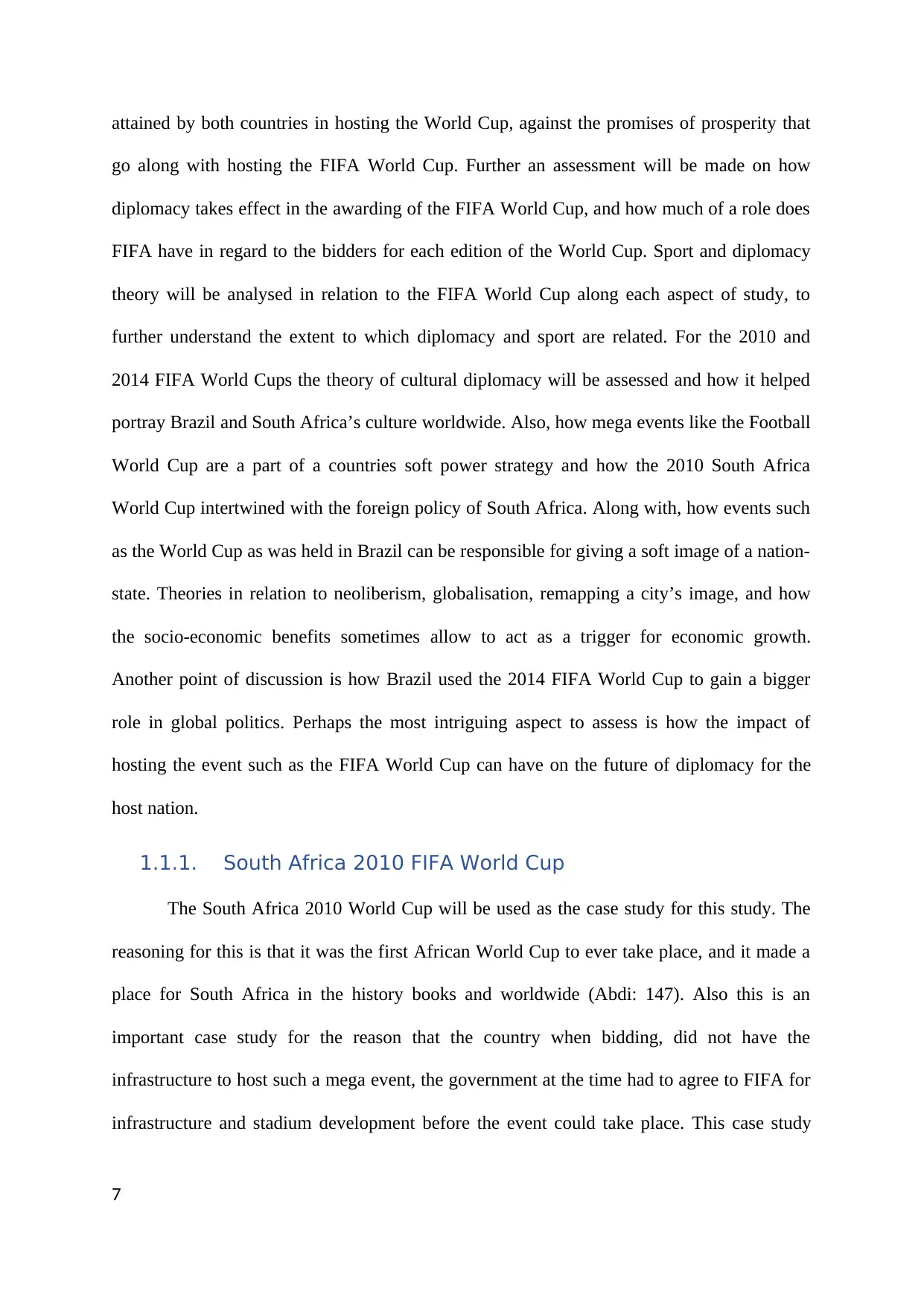
attained by both countries in hosting the World Cup, against the promises of prosperity that
go along with hosting the FIFA World Cup. Further an assessment will be made on how
diplomacy takes effect in the awarding of the FIFA World Cup, and how much of a role does
FIFA have in regard to the bidders for each edition of the World Cup. Sport and diplomacy
theory will be analysed in relation to the FIFA World Cup along each aspect of study, to
further understand the extent to which diplomacy and sport are related. For the 2010 and
2014 FIFA World Cups the theory of cultural diplomacy will be assessed and how it helped
portray Brazil and South Africa’s culture worldwide. Also, how mega events like the Football
World Cup are a part of a countries soft power strategy and how the 2010 South Africa
World Cup intertwined with the foreign policy of South Africa. Along with, how events such
as the World Cup as was held in Brazil can be responsible for giving a soft image of a nation-
state. Theories in relation to neoliberism, globalisation, remapping a city’s image, and how
the socio-economic benefits sometimes allow to act as a trigger for economic growth.
Another point of discussion is how Brazil used the 2014 FIFA World Cup to gain a bigger
role in global politics. Perhaps the most intriguing aspect to assess is how the impact of
hosting the event such as the FIFA World Cup can have on the future of diplomacy for the
host nation.
1.1.1. South Africa 2010 FIFA World Cup
The South Africa 2010 World Cup will be used as the case study for this study. The
reasoning for this is that it was the first African World Cup to ever take place, and it made a
place for South Africa in the history books and worldwide (Abdi: 147). Also this is an
important case study for the reason that the country when bidding, did not have the
infrastructure to host such a mega event, the government at the time had to agree to FIFA for
infrastructure and stadium development before the event could take place. This case study
7
go along with hosting the FIFA World Cup. Further an assessment will be made on how
diplomacy takes effect in the awarding of the FIFA World Cup, and how much of a role does
FIFA have in regard to the bidders for each edition of the World Cup. Sport and diplomacy
theory will be analysed in relation to the FIFA World Cup along each aspect of study, to
further understand the extent to which diplomacy and sport are related. For the 2010 and
2014 FIFA World Cups the theory of cultural diplomacy will be assessed and how it helped
portray Brazil and South Africa’s culture worldwide. Also, how mega events like the Football
World Cup are a part of a countries soft power strategy and how the 2010 South Africa
World Cup intertwined with the foreign policy of South Africa. Along with, how events such
as the World Cup as was held in Brazil can be responsible for giving a soft image of a nation-
state. Theories in relation to neoliberism, globalisation, remapping a city’s image, and how
the socio-economic benefits sometimes allow to act as a trigger for economic growth.
Another point of discussion is how Brazil used the 2014 FIFA World Cup to gain a bigger
role in global politics. Perhaps the most intriguing aspect to assess is how the impact of
hosting the event such as the FIFA World Cup can have on the future of diplomacy for the
host nation.
1.1.1. South Africa 2010 FIFA World Cup
The South Africa 2010 World Cup will be used as the case study for this study. The
reasoning for this is that it was the first African World Cup to ever take place, and it made a
place for South Africa in the history books and worldwide (Abdi: 147). Also this is an
important case study for the reason that the country when bidding, did not have the
infrastructure to host such a mega event, the government at the time had to agree to FIFA for
infrastructure and stadium development before the event could take place. This case study
7
Paraphrase This Document
Need a fresh take? Get an instant paraphrase of this document with our AI Paraphraser
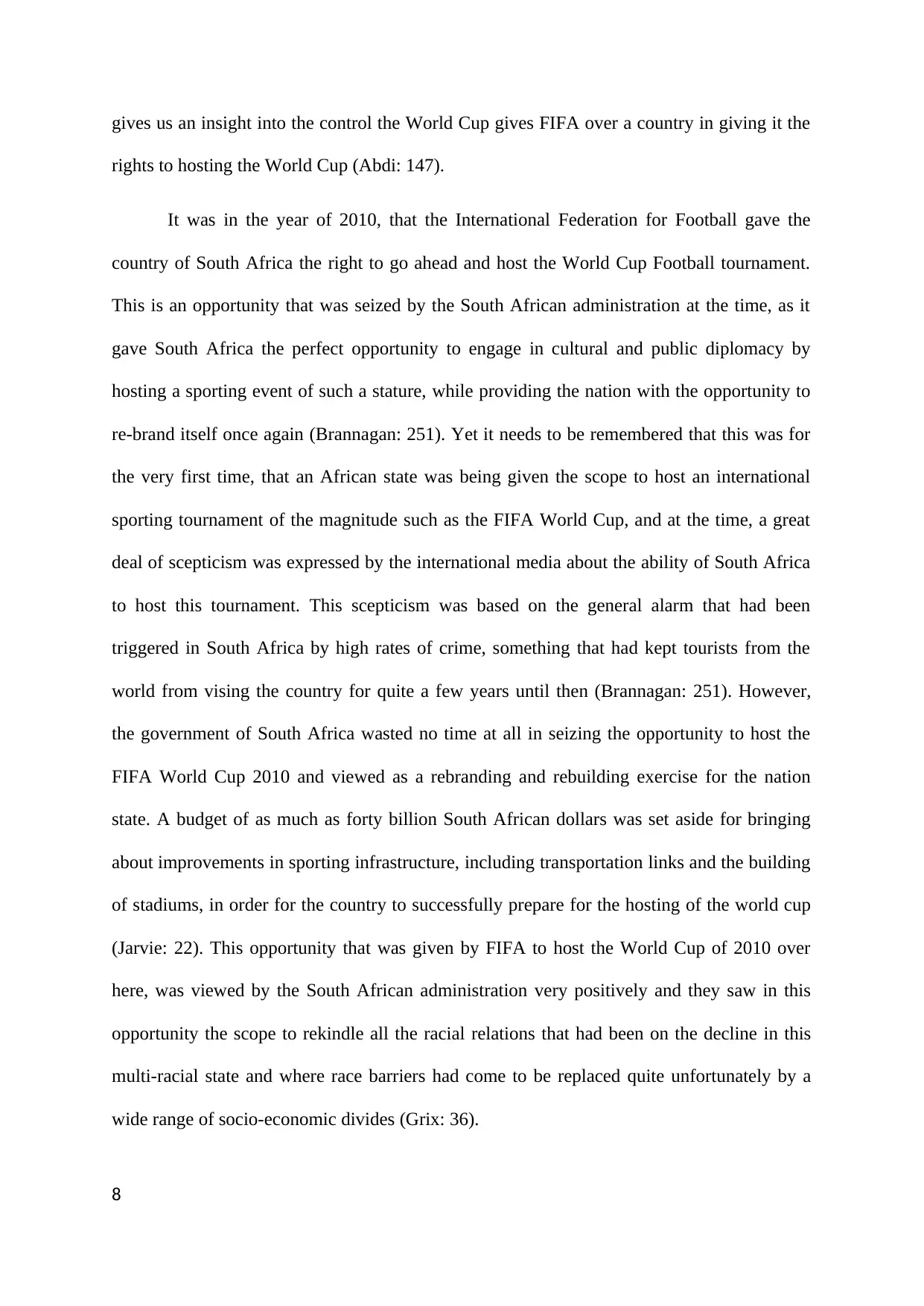
gives us an insight into the control the World Cup gives FIFA over a country in giving it the
rights to hosting the World Cup (Abdi: 147).
It was in the year of 2010, that the International Federation for Football gave the
country of South Africa the right to go ahead and host the World Cup Football tournament.
This is an opportunity that was seized by the South African administration at the time, as it
gave South Africa the perfect opportunity to engage in cultural and public diplomacy by
hosting a sporting event of such a stature, while providing the nation with the opportunity to
re-brand itself once again (Brannagan: 251). Yet it needs to be remembered that this was for
the very first time, that an African state was being given the scope to host an international
sporting tournament of the magnitude such as the FIFA World Cup, and at the time, a great
deal of scepticism was expressed by the international media about the ability of South Africa
to host this tournament. This scepticism was based on the general alarm that had been
triggered in South Africa by high rates of crime, something that had kept tourists from the
world from vising the country for quite a few years until then (Brannagan: 251). However,
the government of South Africa wasted no time at all in seizing the opportunity to host the
FIFA World Cup 2010 and viewed as a rebranding and rebuilding exercise for the nation
state. A budget of as much as forty billion South African dollars was set aside for bringing
about improvements in sporting infrastructure, including transportation links and the building
of stadiums, in order for the country to successfully prepare for the hosting of the world cup
(Jarvie: 22). This opportunity that was given by FIFA to host the World Cup of 2010 over
here, was viewed by the South African administration very positively and they saw in this
opportunity the scope to rekindle all the racial relations that had been on the decline in this
multi-racial state and where race barriers had come to be replaced quite unfortunately by a
wide range of socio-economic divides (Grix: 36).
8
rights to hosting the World Cup (Abdi: 147).
It was in the year of 2010, that the International Federation for Football gave the
country of South Africa the right to go ahead and host the World Cup Football tournament.
This is an opportunity that was seized by the South African administration at the time, as it
gave South Africa the perfect opportunity to engage in cultural and public diplomacy by
hosting a sporting event of such a stature, while providing the nation with the opportunity to
re-brand itself once again (Brannagan: 251). Yet it needs to be remembered that this was for
the very first time, that an African state was being given the scope to host an international
sporting tournament of the magnitude such as the FIFA World Cup, and at the time, a great
deal of scepticism was expressed by the international media about the ability of South Africa
to host this tournament. This scepticism was based on the general alarm that had been
triggered in South Africa by high rates of crime, something that had kept tourists from the
world from vising the country for quite a few years until then (Brannagan: 251). However,
the government of South Africa wasted no time at all in seizing the opportunity to host the
FIFA World Cup 2010 and viewed as a rebranding and rebuilding exercise for the nation
state. A budget of as much as forty billion South African dollars was set aside for bringing
about improvements in sporting infrastructure, including transportation links and the building
of stadiums, in order for the country to successfully prepare for the hosting of the world cup
(Jarvie: 22). This opportunity that was given by FIFA to host the World Cup of 2010 over
here, was viewed by the South African administration very positively and they saw in this
opportunity the scope to rekindle all the racial relations that had been on the decline in this
multi-racial state and where race barriers had come to be replaced quite unfortunately by a
wide range of socio-economic divides (Grix: 36).
8
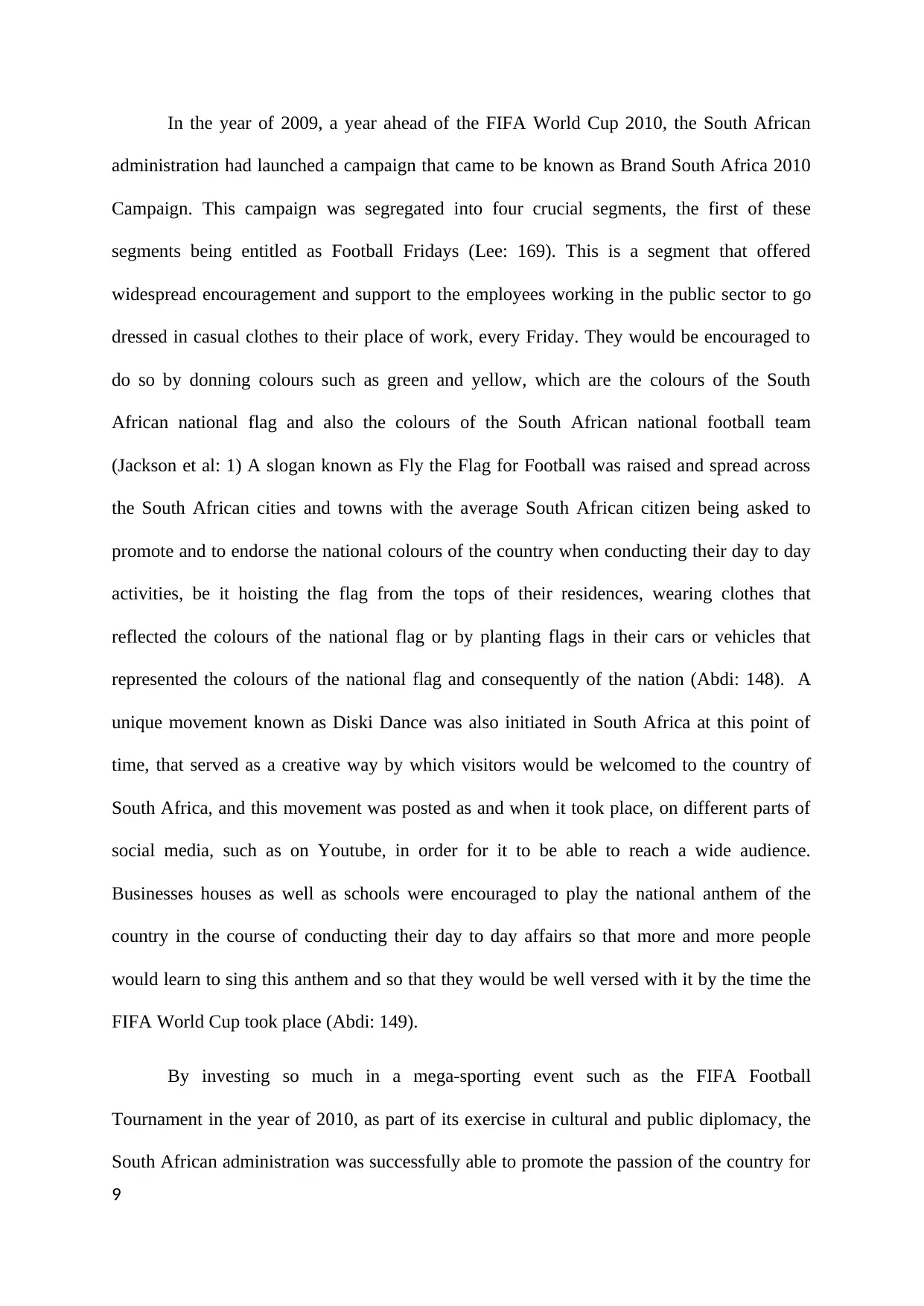
In the year of 2009, a year ahead of the FIFA World Cup 2010, the South African
administration had launched a campaign that came to be known as Brand South Africa 2010
Campaign. This campaign was segregated into four crucial segments, the first of these
segments being entitled as Football Fridays (Lee: 169). This is a segment that offered
widespread encouragement and support to the employees working in the public sector to go
dressed in casual clothes to their place of work, every Friday. They would be encouraged to
do so by donning colours such as green and yellow, which are the colours of the South
African national flag and also the colours of the South African national football team
(Jackson et al: 1) A slogan known as Fly the Flag for Football was raised and spread across
the South African cities and towns with the average South African citizen being asked to
promote and to endorse the national colours of the country when conducting their day to day
activities, be it hoisting the flag from the tops of their residences, wearing clothes that
reflected the colours of the national flag or by planting flags in their cars or vehicles that
represented the colours of the national flag and consequently of the nation (Abdi: 148). A
unique movement known as Diski Dance was also initiated in South Africa at this point of
time, that served as a creative way by which visitors would be welcomed to the country of
South Africa, and this movement was posted as and when it took place, on different parts of
social media, such as on Youtube, in order for it to be able to reach a wide audience.
Businesses houses as well as schools were encouraged to play the national anthem of the
country in the course of conducting their day to day affairs so that more and more people
would learn to sing this anthem and so that they would be well versed with it by the time the
FIFA World Cup took place (Abdi: 149).
By investing so much in a mega-sporting event such as the FIFA Football
Tournament in the year of 2010, as part of its exercise in cultural and public diplomacy, the
South African administration was successfully able to promote the passion of the country for
9
administration had launched a campaign that came to be known as Brand South Africa 2010
Campaign. This campaign was segregated into four crucial segments, the first of these
segments being entitled as Football Fridays (Lee: 169). This is a segment that offered
widespread encouragement and support to the employees working in the public sector to go
dressed in casual clothes to their place of work, every Friday. They would be encouraged to
do so by donning colours such as green and yellow, which are the colours of the South
African national flag and also the colours of the South African national football team
(Jackson et al: 1) A slogan known as Fly the Flag for Football was raised and spread across
the South African cities and towns with the average South African citizen being asked to
promote and to endorse the national colours of the country when conducting their day to day
activities, be it hoisting the flag from the tops of their residences, wearing clothes that
reflected the colours of the national flag or by planting flags in their cars or vehicles that
represented the colours of the national flag and consequently of the nation (Abdi: 148). A
unique movement known as Diski Dance was also initiated in South Africa at this point of
time, that served as a creative way by which visitors would be welcomed to the country of
South Africa, and this movement was posted as and when it took place, on different parts of
social media, such as on Youtube, in order for it to be able to reach a wide audience.
Businesses houses as well as schools were encouraged to play the national anthem of the
country in the course of conducting their day to day affairs so that more and more people
would learn to sing this anthem and so that they would be well versed with it by the time the
FIFA World Cup took place (Abdi: 149).
By investing so much in a mega-sporting event such as the FIFA Football
Tournament in the year of 2010, as part of its exercise in cultural and public diplomacy, the
South African administration was successfully able to promote the passion of the country for
9
⊘ This is a preview!⊘
Do you want full access?
Subscribe today to unlock all pages.

Trusted by 1+ million students worldwide
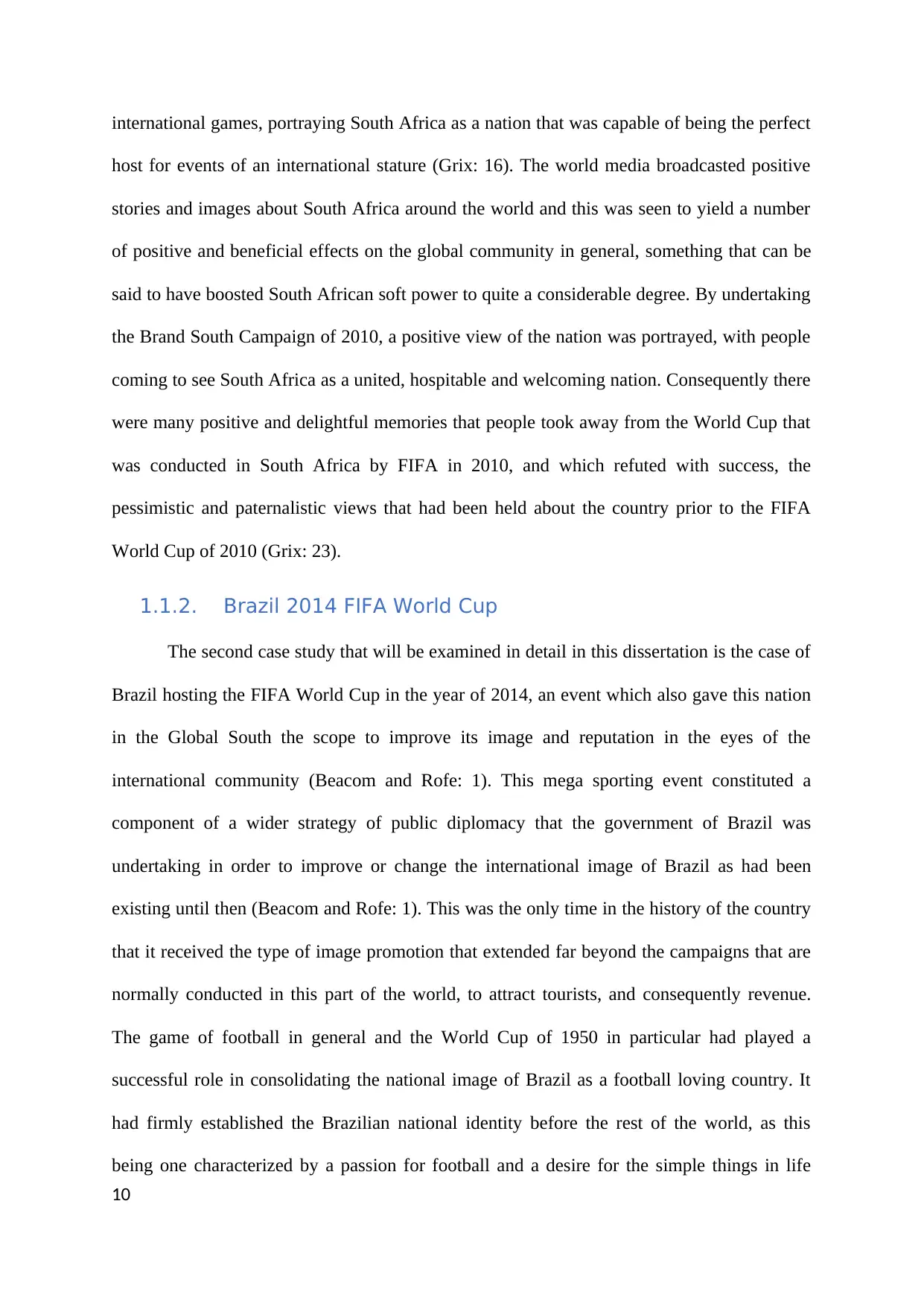
international games, portraying South Africa as a nation that was capable of being the perfect
host for events of an international stature (Grix: 16). The world media broadcasted positive
stories and images about South Africa around the world and this was seen to yield a number
of positive and beneficial effects on the global community in general, something that can be
said to have boosted South African soft power to quite a considerable degree. By undertaking
the Brand South Campaign of 2010, a positive view of the nation was portrayed, with people
coming to see South Africa as a united, hospitable and welcoming nation. Consequently there
were many positive and delightful memories that people took away from the World Cup that
was conducted in South Africa by FIFA in 2010, and which refuted with success, the
pessimistic and paternalistic views that had been held about the country prior to the FIFA
World Cup of 2010 (Grix: 23).
1.1.2. Brazil 2014 FIFA World Cup
The second case study that will be examined in detail in this dissertation is the case of
Brazil hosting the FIFA World Cup in the year of 2014, an event which also gave this nation
in the Global South the scope to improve its image and reputation in the eyes of the
international community (Beacom and Rofe: 1). This mega sporting event constituted a
component of a wider strategy of public diplomacy that the government of Brazil was
undertaking in order to improve or change the international image of Brazil as had been
existing until then (Beacom and Rofe: 1). This was the only time in the history of the country
that it received the type of image promotion that extended far beyond the campaigns that are
normally conducted in this part of the world, to attract tourists, and consequently revenue.
The game of football in general and the World Cup of 1950 in particular had played a
successful role in consolidating the national image of Brazil as a football loving country. It
had firmly established the Brazilian national identity before the rest of the world, as this
being one characterized by a passion for football and a desire for the simple things in life
10
host for events of an international stature (Grix: 16). The world media broadcasted positive
stories and images about South Africa around the world and this was seen to yield a number
of positive and beneficial effects on the global community in general, something that can be
said to have boosted South African soft power to quite a considerable degree. By undertaking
the Brand South Campaign of 2010, a positive view of the nation was portrayed, with people
coming to see South Africa as a united, hospitable and welcoming nation. Consequently there
were many positive and delightful memories that people took away from the World Cup that
was conducted in South Africa by FIFA in 2010, and which refuted with success, the
pessimistic and paternalistic views that had been held about the country prior to the FIFA
World Cup of 2010 (Grix: 23).
1.1.2. Brazil 2014 FIFA World Cup
The second case study that will be examined in detail in this dissertation is the case of
Brazil hosting the FIFA World Cup in the year of 2014, an event which also gave this nation
in the Global South the scope to improve its image and reputation in the eyes of the
international community (Beacom and Rofe: 1). This mega sporting event constituted a
component of a wider strategy of public diplomacy that the government of Brazil was
undertaking in order to improve or change the international image of Brazil as had been
existing until then (Beacom and Rofe: 1). This was the only time in the history of the country
that it received the type of image promotion that extended far beyond the campaigns that are
normally conducted in this part of the world, to attract tourists, and consequently revenue.
The game of football in general and the World Cup of 1950 in particular had played a
successful role in consolidating the national image of Brazil as a football loving country. It
had firmly established the Brazilian national identity before the rest of the world, as this
being one characterized by a passion for football and a desire for the simple things in life
10
Paraphrase This Document
Need a fresh take? Get an instant paraphrase of this document with our AI Paraphraser
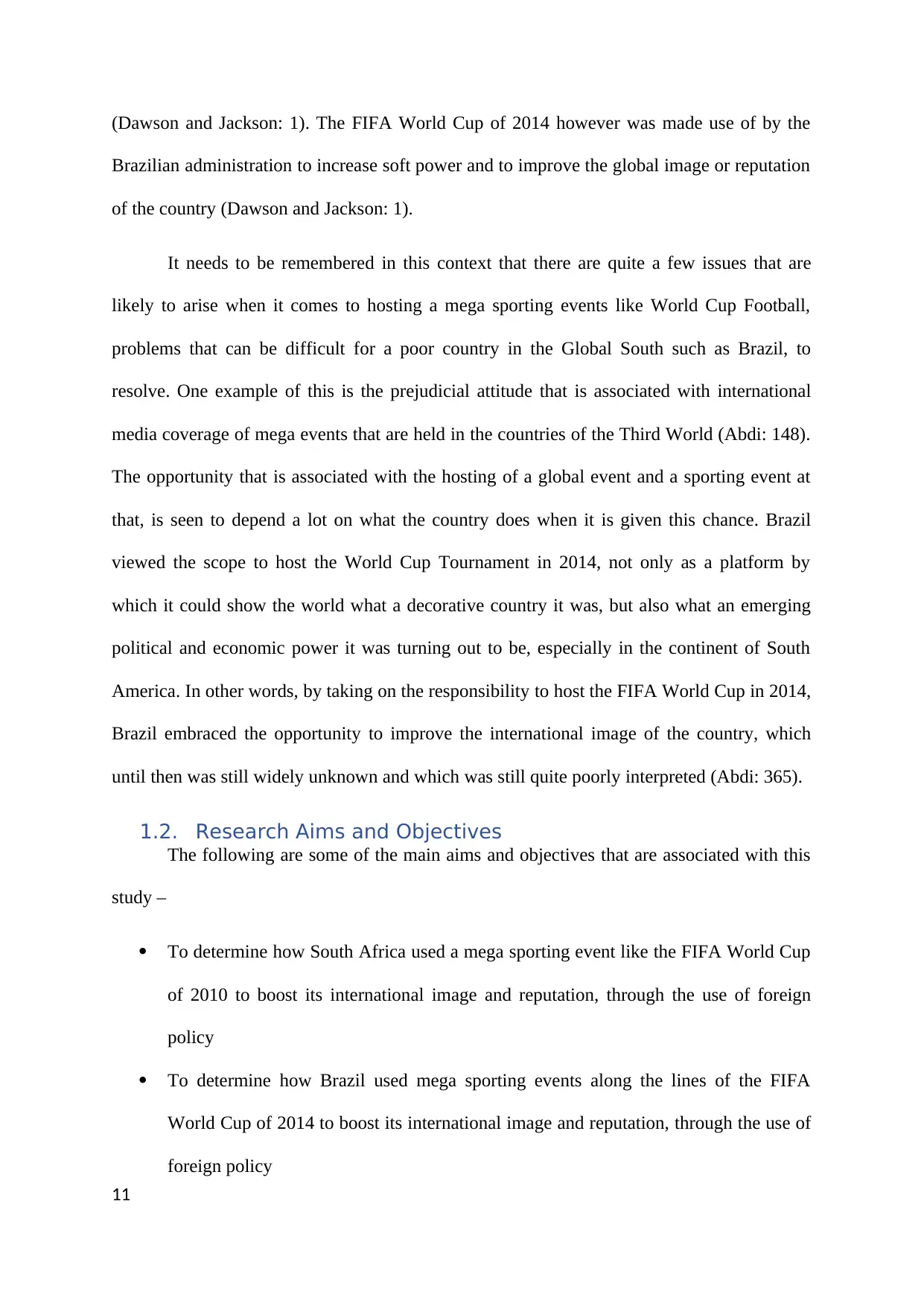
(Dawson and Jackson: 1). The FIFA World Cup of 2014 however was made use of by the
Brazilian administration to increase soft power and to improve the global image or reputation
of the country (Dawson and Jackson: 1).
It needs to be remembered in this context that there are quite a few issues that are
likely to arise when it comes to hosting a mega sporting events like World Cup Football,
problems that can be difficult for a poor country in the Global South such as Brazil, to
resolve. One example of this is the prejudicial attitude that is associated with international
media coverage of mega events that are held in the countries of the Third World (Abdi: 148).
The opportunity that is associated with the hosting of a global event and a sporting event at
that, is seen to depend a lot on what the country does when it is given this chance. Brazil
viewed the scope to host the World Cup Tournament in 2014, not only as a platform by
which it could show the world what a decorative country it was, but also what an emerging
political and economic power it was turning out to be, especially in the continent of South
America. In other words, by taking on the responsibility to host the FIFA World Cup in 2014,
Brazil embraced the opportunity to improve the international image of the country, which
until then was still widely unknown and which was still quite poorly interpreted (Abdi: 365).
1.2. Research Aims and Objectives
The following are some of the main aims and objectives that are associated with this
study –
To determine how South Africa used a mega sporting event like the FIFA World Cup
of 2010 to boost its international image and reputation, through the use of foreign
policy
To determine how Brazil used mega sporting events along the lines of the FIFA
World Cup of 2014 to boost its international image and reputation, through the use of
foreign policy
11
Brazilian administration to increase soft power and to improve the global image or reputation
of the country (Dawson and Jackson: 1).
It needs to be remembered in this context that there are quite a few issues that are
likely to arise when it comes to hosting a mega sporting events like World Cup Football,
problems that can be difficult for a poor country in the Global South such as Brazil, to
resolve. One example of this is the prejudicial attitude that is associated with international
media coverage of mega events that are held in the countries of the Third World (Abdi: 148).
The opportunity that is associated with the hosting of a global event and a sporting event at
that, is seen to depend a lot on what the country does when it is given this chance. Brazil
viewed the scope to host the World Cup Tournament in 2014, not only as a platform by
which it could show the world what a decorative country it was, but also what an emerging
political and economic power it was turning out to be, especially in the continent of South
America. In other words, by taking on the responsibility to host the FIFA World Cup in 2014,
Brazil embraced the opportunity to improve the international image of the country, which
until then was still widely unknown and which was still quite poorly interpreted (Abdi: 365).
1.2. Research Aims and Objectives
The following are some of the main aims and objectives that are associated with this
study –
To determine how South Africa used a mega sporting event like the FIFA World Cup
of 2010 to boost its international image and reputation, through the use of foreign
policy
To determine how Brazil used mega sporting events along the lines of the FIFA
World Cup of 2014 to boost its international image and reputation, through the use of
foreign policy
11
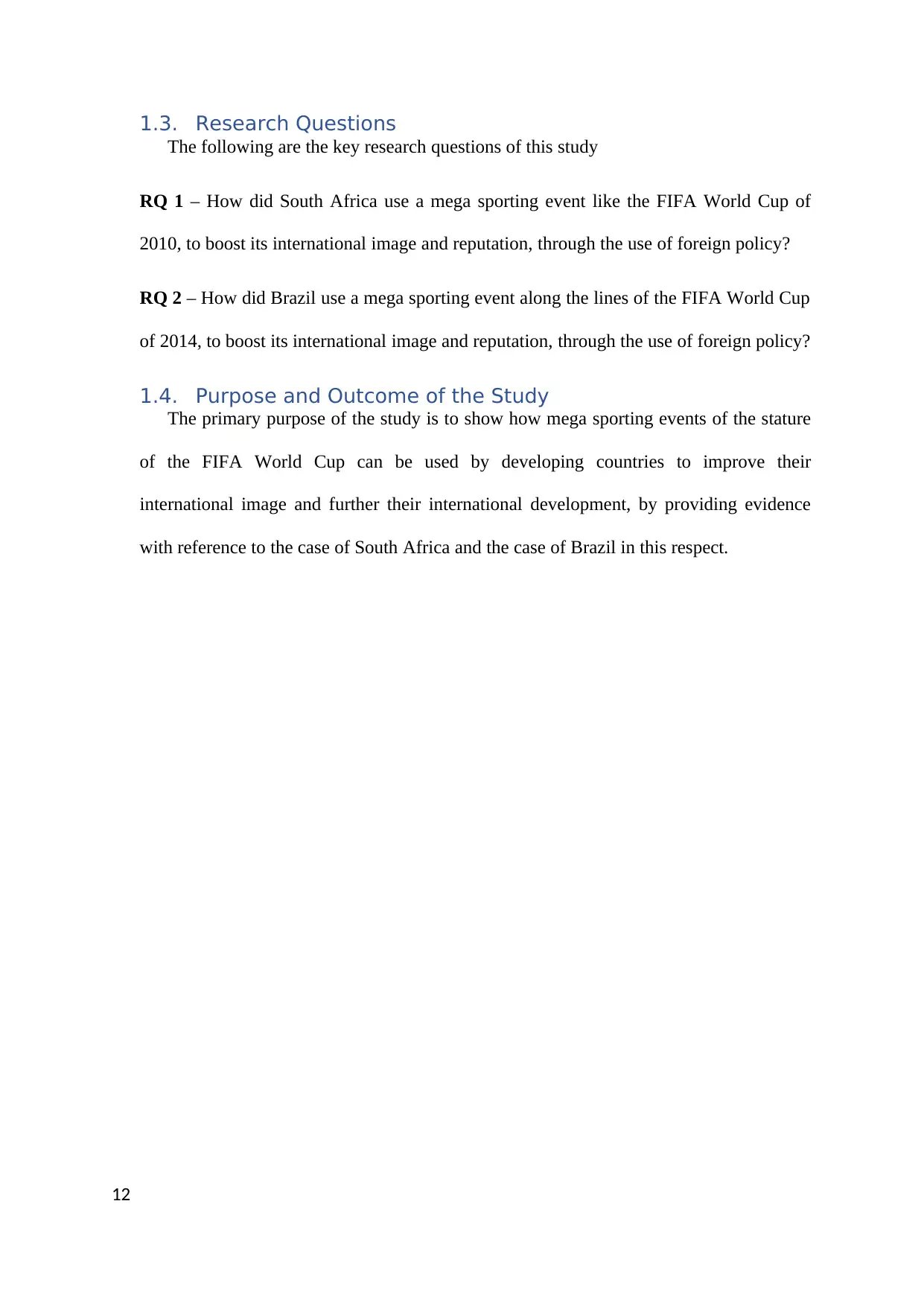
1.3. Research Questions
The following are the key research questions of this study
RQ 1 – How did South Africa use a mega sporting event like the FIFA World Cup of
2010, to boost its international image and reputation, through the use of foreign policy?
RQ 2 – How did Brazil use a mega sporting event along the lines of the FIFA World Cup
of 2014, to boost its international image and reputation, through the use of foreign policy?
1.4. Purpose and Outcome of the Study
The primary purpose of the study is to show how mega sporting events of the stature
of the FIFA World Cup can be used by developing countries to improve their
international image and further their international development, by providing evidence
with reference to the case of South Africa and the case of Brazil in this respect.
12
The following are the key research questions of this study
RQ 1 – How did South Africa use a mega sporting event like the FIFA World Cup of
2010, to boost its international image and reputation, through the use of foreign policy?
RQ 2 – How did Brazil use a mega sporting event along the lines of the FIFA World Cup
of 2014, to boost its international image and reputation, through the use of foreign policy?
1.4. Purpose and Outcome of the Study
The primary purpose of the study is to show how mega sporting events of the stature
of the FIFA World Cup can be used by developing countries to improve their
international image and further their international development, by providing evidence
with reference to the case of South Africa and the case of Brazil in this respect.
12
⊘ This is a preview!⊘
Do you want full access?
Subscribe today to unlock all pages.

Trusted by 1+ million students worldwide
1 out of 50
Related Documents
Your All-in-One AI-Powered Toolkit for Academic Success.
+13062052269
info@desklib.com
Available 24*7 on WhatsApp / Email
![[object Object]](/_next/static/media/star-bottom.7253800d.svg)
Unlock your academic potential
Copyright © 2020–2025 A2Z Services. All Rights Reserved. Developed and managed by ZUCOL.





